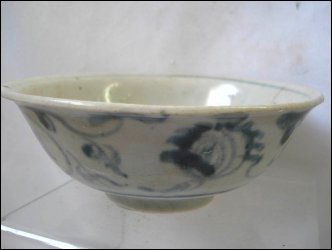Heavily potted with a thick, creamy glaze. This
is considered minyao (common ware). This is a good example of early Ming
from a southern kiln. Aside from the obvious signs of age and wear,
it displays some very good characteristics that often accompany authentic
early Ming pieces.
The body is more dense and porous, bordering on that
of clay pottery than that of porcelain. There are two reasons for this.
The kaolin (primary clay) and the baidunzi (glaze) is from a Southern China
source and it was fired in an early wood kiln at a lower temperature.
This bowl also displays an unglazed circle on the inside
and what is referred to as radiating 'chatter marks' on the underside of
the unglazed foot.
The unglazed circle is often seen on earlier Song and
Yuan wares and is a result of stacking pieces in the kiln for firing. You
will not find this on finer pieces or on Imperial ware. The glaze was
wiped off so the pieces wouldn't stick together during firing. The
size of the unglazed ring will usually be commensurate with the foot of the
piece, often showing a small amount of glaze that ran down from the stacked
piece above.
The chatter-marks on the unglazed foot are caused by
the tool used to remove (scoop out) the clay of the foot. They are not
caused by tool vibration in removing the piece from the potters wheel as
most literature leads one to believe. Later pieces with glazed footing
will sometimes have these visible beneath the glaze, though very slight.
The decoration is three roughly drawn lotus blooms
on a vine.
|










![]()